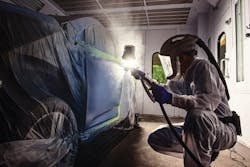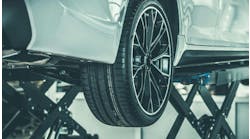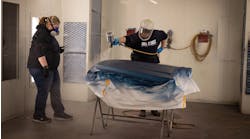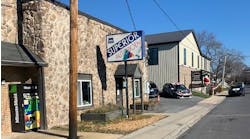Jason Fortner is pushing his paint game to new levels. As a 35-year-old painter for Columbia Auto Center in Columbia, Md., Fortner’s ingenuity, passion and ability to connect with other painters have pushed the quality of his product to all-time highs. Always looking for ways to improve, Fortner has found techniques and tools that have practically eliminated redos and comebacks while allowing him to average more than 150 labor hours a week.
I started in the collision industry when I was 16, doing a work program through my school. Part of my shop course was to leave early and go work at the body shop. I started by helping a body guy, but always wanted to be a painter. After a couple months, he noticed, and finally asked me if I wanted to switch.
I ended up going to work on the other end of the shop as the painter’s helper for three years. I learned a lot of the techniques in school, but it was totally different out in the real world.
At my current shop, we originally started with just one booth for two painters, but when my boss saw how I was producing work and that we still had cars lined up outside, he decided he needed to get another booth for the shop.
I talked him into getting the Accudraft Titan. It’s totally transformed our shop; our production and everything else is a lot faster now. Insurance companies are seeing that we can do more, so they’re sending us more work.
It’s a great booth designed for waterborne paint, with more airflow and better light. So I’ve done the best I can to keep it in good shape.
In the winter, I suggested my boss install fans in the shop to use the heat from the booth to warm the entire shop. It’s been a great way to save energy in the cold months.
I maintain my booth by using Car System’s Booth Mask from about halfway up the wall and above; below that, I use 3M’s Dirt Trap. One of the things I’ve found, is that by putting Dirt Trap on the floor, it actually bounces more light up onto the lower parts of the car.
My boss wasn’t going to do any of these protective things until I said, “What’s a little bit of extra money when you’re protecting your $100,000 investment?” After he saw how clean and nice my booth looked, he had our original booth sanded, repainted and the Dirt Trap installed, even though our other painter wasn’t much of a fan.
We’ve even put the Dirt Trap into our mixing room. With two painters, our mixing room gets pretty dirty, and it helps keep our jobs going smoothly.
Another way I keep my booth clean is by always having a separate prep suit and paint suit. When I get done prepping a car, I slip into my paint suit so that I can keep the contaminants off of me and separate from the spray booth.
I put my paint suit in a bag and I zip it up, so it doesn’t get contaminated. It really cuts down on the amount of dust that gets into my booth, and makes jobs go a lot faster when the paint stays clean.
I like to have a good plan of attack for each day. If I know I have three cars lined up for the next day, I’ll try to do all my priming the night before, so I can let it dry overnight. When I get in the next day, I can sand them, tape them and hit the booth.
I get in touch with my boss every morning, to get a feel for what his biggest priorities are, whether it’s a quick fix or something that needs to be buffed or touched-up. Sometimes my days don’t go according to plan, so I have to adapt.
Ideally my day would start with me getting into the shop and being able to just start spraying. I want to have all my paint made the night before so that once a car is done baking, I’ve already prepped the next car and I’m ready to go.
To keep the process going smoothly, I try to get my body guys to always wipe down the panels with a wet microfiber cloth to cut down on the dust in the shop. It’s especially important in the winter when the doors are all closed and there’s not much ventilation.
If you don’t wipe it down, the dust gets all over your clothes, in the air, and will inevitably get into your booth. I even wipe the panels down with soapy water before I begin sanding; it cuts down on clogging and the amount of sandpaper I use, and ultimately makes the process go faster.
With a water-based paint, it’s even more important to get rid of anything that will affect the way the paint dries and eliminate fisheyes, so I have a soapy squirt bottle on my tool cart at all times.
One of my best inventions is my mobile light. A buddy traded me a horticultural lamp for some work that I did to his car. It just sat around my garage for a while, but with eight very bright fluorescent bulbs I thought I’d bring it to the shop. I began using it to help me see detail work in the booth and when I did my prep work. Then I had one of my body guys weld together a stand, and after attaching some wheels, I had a rolling detail light that I could take anywhere in the shop.
It helps me find pinholes and all types of stuff that you don’t normally see until you get into the booth. Now, once I get into my booth, I don’t have to stop.
3M’s Sun Gun also helps me tremendously. If it weren’t for the Sun Gun, I’d have color issues and a couple of redos here and there. Without it, you don’t get a true look as to what the paint will look like outside. I even turn off the lights in my booth, and hit it with the Sun Gun. It shows everything and really improves the blending process. I didn’t even know the Sun Gun was available until I saw it on Instagram.
I’ve been working on designing my own spray gun holder for while. My brother-in-law asked me what I wanted for Christmas, and I told him I wanted spray gun holders that would hang my guns with the cups attached. He then created one of my designs on a 3D printer. We’ve been tweaking the design since then, waiting for the perfect product before we begin selling them.
I’ve added magnetic attachments to all of my tools, along with using magnetic shelves in the booth. They stick right to the wall wherever I go in my booth and keep me from having to drill holes into the booth walls. I’m able to take my tools to where I’m working so I don’t have to always walk back and forth.
Another vital part of making my job in the booth easier is having quality fender and bumper stands. They allow me to have my work at any angle and keep my processes flowing well, so that I can really focus on the paint once the spray gun is in my hand.
Being on Instagram has helped broaden my skills. It allows me to actually communicate with other painters. I had never been able to see other people’s work or ask them questions before. I often ask what they’re spraying with or how they do what they do.
I used to use a ton of paper masking off my jobs, then I saw how a guy used all plastic instead. It’s really cut down on waste and makes the process faster.
If I have a new product, I share it on Instagram and let other guys know what I think. It’s also helped me have great relationships with our paint and other product reps. They know that they can send me new products to test out, and that those products will get on my Instagram feed.
The help goes both ways. Myself and other painters help each other out with colors, when someone posts a paint code, we can let them know our suggestions and any special layering we might do. Multiple people will generally have a suggestion for getting a better match. It’s great because we can draw from a lot of other people’s experience and we all get better.
With all the new paint products and little techniques I’ve found since I began using Instagram, I often think, “Man, why didn’t they have this when I started?” Over the past year, my paint game has stepped up tremendously.




